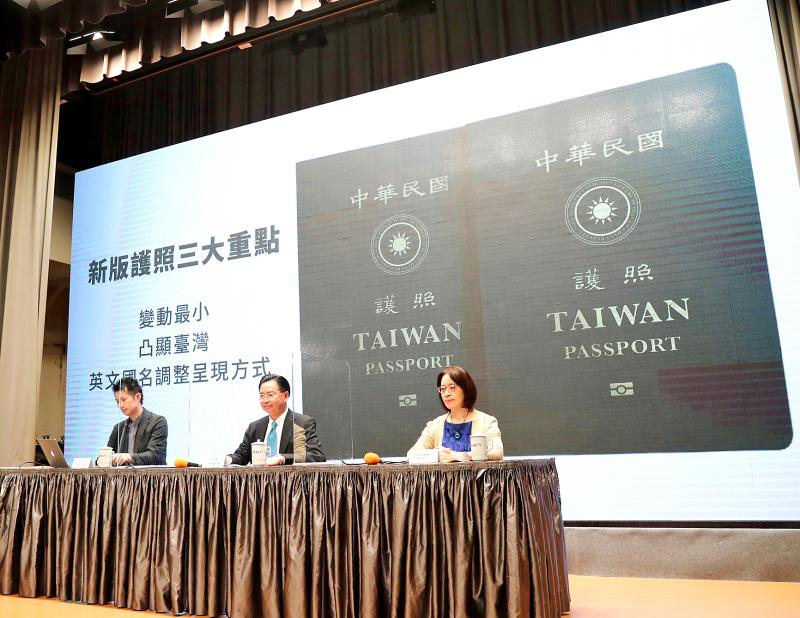The Executive Yuan yesterday unveiled a redesigned cover for the Republic of China (ROC) passport, which highlights the English word “Taiwan,” prompting criticism from the Chinese Nationalist Party (KMT), which said that reducing the size of the ROC text would not help enhance the nation’s international status.
The new design would become available in January next year, officials said.
The design entails minimal changes, highlights “Taiwan” and changes the way in which the nation’s official title is displayed, Minister of Foreign Affairs Joseph Wu (吳釗燮) told a news conference in Taipei.

Photo: CNA
The ROC title, prominently displayed on the current passport, is in a much smaller font and encircles the national emblem in the new design, a sample released by the Ministry of Foreign Affairs showed.
The word “Taiwan” is placed directly above the word “passport,” making it obvious at first glance that it is a Taiwanese passport, a change from the words being separated by the Chinese characters for “passport,” Wu said.
The national emblem was retained, as more than 90 percent of passports bear their national emblem, with fewer than 20 nations not doing so, he said.
Since COVID-19 was first reported in China late last year, many Taiwanese have expressed concern that their passports might mislead foreigners into thinking that they are Chinese, Wu said.
With controls on inbound travelers stepped up at airports all over the world, the call for the passport cover to be revised to prevent Taiwanese from being subjected to “unnecessary treatment” has intensified, he said.
The redesign was proposed in accordance with a motion passed by lawmakers in July, which mandated that the passport be redesigned to enable Taiwanese to distinguish themselves from Chinese, Wu said.
An intergovernmental panel deliberated the design and it was approved by the Executive Yuan last week, he said.
The ministry would do its best to make the passports available in January next year and would notify all countries of the redesign two months prior to their release, Wu said.
People who want a new passport should follow the same procedure for renewing a passport at the Bureau of Consular Affairs, he said, adding that it would cost NT$1,300 — the same as a normal replacement.
Current passports would remain valid until their expiry date, Wu said.
All the costs for production of the new passports would be covered by existing ministry funds, he said.
The bureau plans to produce 1.5 million new passports next year, down from 1.7 million in previous years, but the estimate might drop depending on the global COVID-19 situation, Bureau of Consular Affairs Director-General Phoebe Yeh (葉非比) said.
Meanwhile, the KMT said that the new design would not help improve travel for most Taiwanese or help the nation’s international status.
The design should take into account Taiwan’s special “national conditions” and highlight its official English name, the party said in a statement.
The highlighting of “Taiwan” did not require the official English-language name, the ROC, to be minimized, the party said.
The current passport already has “Taiwan” and it is a completely different color from the Chinese passport, the KMT said, adding that there is little chance of other countries confusing the two.
The New Power Party (NPP) said that the national emblem should be changed, as it is similar to the KMT’s emblem.
“We find it unacceptable that the Ministry of Foreign Affairs kept the national emblem, which closely resembles the KMT’s emblem. As such, we plan to propose an amendment to the National Emblem and National Flag of the Republic of China Act (中華民國國徽國旗法) in the upcoming legislative session, which would replace the current national emblem with one with imagery of Taiwan,” the NPP said.
Additional reporting by Sherry Hsiao and Shelley Shan

TRAGEDY STRIKES TAIPEI: The suspect died after falling off a building after he threw smoke grenades into Taipei Main Station and went on a killing spree in Zhongshan A 27-year-old suspect allegedly threw smoke grenades in Taipei Main Station and then proceeded to Zhongshan MRT Station in a random killing spree that resulted in the death of the suspect and two other civilians, and seven injured, including one in critical condition, as of press time last night. The suspect, identified as a man surnamed Chang Wen (張文), allegedly began the attack at Taipei Main Station, the Taipei Fire Department said, adding that it received a report at 5:24pm that smoke grenades had been thrown in the station. One man in his 50s was rushed to hospital after a cardiac arrest

SAFETY FIRST: Double the number of police were deployed at the Taipei Marathon, while other cities released plans to bolster public event safety Authorities across Taiwan have stepped up security measures ahead of Christmas and New Year events, following a knife and smoke bomb attack in Taipei on Friday that left four people dead and 11 injured. In a bid to prevent potential copycat incidents, police deployments have been expanded for large gatherings, transport hubs, and other crowded public spaces, according to official statements from police and city authorities. Taipei Mayor Chiang Wan-an (蔣萬安) said the city has “comprehensively raised security readiness” in crowded areas, increased police deployments with armed officers, and intensified patrols during weekends and nighttime hours. For large-scale events, security checkpoints and explosives

A car bomb killed a senior Russian general in southern Moscow yesterday morning, the latest high-profile army figure to be blown up in a blast that came just hours after Russian and Ukrainian delegates held separate talks in Miami on a plan to end the war. Kyiv has not commented on the incident, but Russian investigators said they were probing whether the blast was “linked” to “Ukrainian special forces.” The attack was similar to other assassinations of generals and pro-war figures that have either been claimed, or are widely believed to have been orchestrated, by Ukraine. Russian Lieutenant General Fanil Sarvarov, 56, head

PUBLIC SAFETY: The premier said that security would be tightened in transport hubs, while President Lai commended the public for their bravery The government is to deploy more police, including rapid response units, in crowded public areas to ensure a swift response to any threats, President William Lai (賴清德) said yesterday after a knife attack killed three people and injured 11 in Taipei the previous day. Lai made the remarks following a briefing by the National Police Agency on the progress of the investigation, saying that the attack underscored the importance of cooperation in public security between the central and local governments. The attack unfolded in the early evening on Friday around Taipei Main Station’s M7 exit and later near the Taipei MRT’s Zhongshan